Family : Corvidae

Text © Dr. Gianfranco Colombo

English translation by Mario Beltramini
With a specific royal measure, on Sept. 13th, 1986, the soldier George, enlisted in 1975, has been officially exonerated from the service as Warder at the Tower of London and relocated in Wales, due to his unsatisfactory conduct after the attack and destruction of some TV antennas.
This was following an analogous fact, when in 1981, the soldier Grog, after 21 years of faithful service to the Crown of Egland, left his guard post at the Tower of London, preferring a nearby pub, perhaps attracted by the drink having his same name.
Other unspeakable facts did occur during the 450 years from the beginning of this particular and privileged activity and all are faithfully noted, with painstaking patience, in the registers of the Tower of London, drawn up by the Beefeaters or, better, called the Yeomen Wardens of Her Majesty’s Royal Palace and Fortress the Tower of London, or, more pompously translated, Wardens of Her Majesty, of the Royal Palace and of the Fortress of the Tower of London.
By the way, Georg and Grog are ravens, at the service of Their Majesties, the Kings of the United Kingdom.
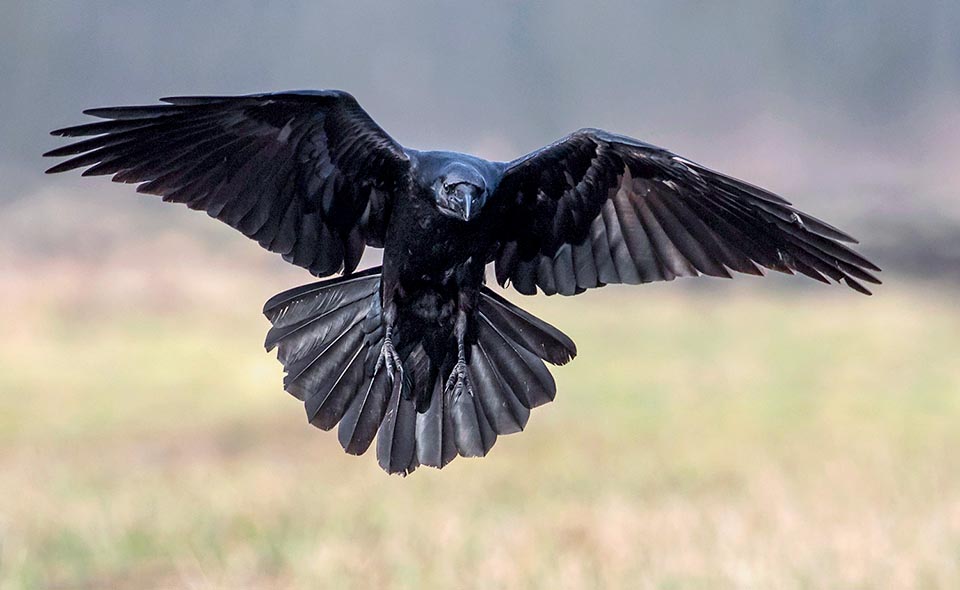
A vulture? No, but almost: it’s a Common raven (Corvus corax) who has just sighted a carrion © Gianfranco Colombo
That in the military ranks of every nation, exists a special structure for the personal defense of the Ruler or of the Political Leader, is a well-known matter. Safeguarding the leader, means protecting the Homeland itself. Moreover, it has never been a strange thing and it is well known that inside the special corps exist, besides real armed soldiers, small units that benefit from the aid of animals.
Hannibal and Cyrus the Great had the elephants, the Greeks, in battle, had the bees, the Mesopotamian peoples, the scorpions, the Visconti and the Sforza the ferocious mastiffs, and today we have dogs that smell drugs and explosives. Hence nothing strange to know that the English regnants have since centuries enlisted their troops, in defense of the Crown, croaking and irritating, that report any inappropriate presence in their historical royal residences!
After all, also Romans, in 390 BC, had already used this opportunity for the defense of Roma, with the famous Geese of the Capitoline Hill, that, with their screams, did stop momentarily the Gauls of Brenno, while waiting for the arrival of the soldiers of Marcus Furius Camillus!
“If the ravens of London Tower will die or will fly away, the Crown will fall and with-it Great Britain!”
This is what an old Anglo-Saxon saying recites, then if in the centuries it has become a mere superstition instead of an archaic way of defense, this is not verifiable, however all do believe in it and insist on maintaining this special “body of guards”.
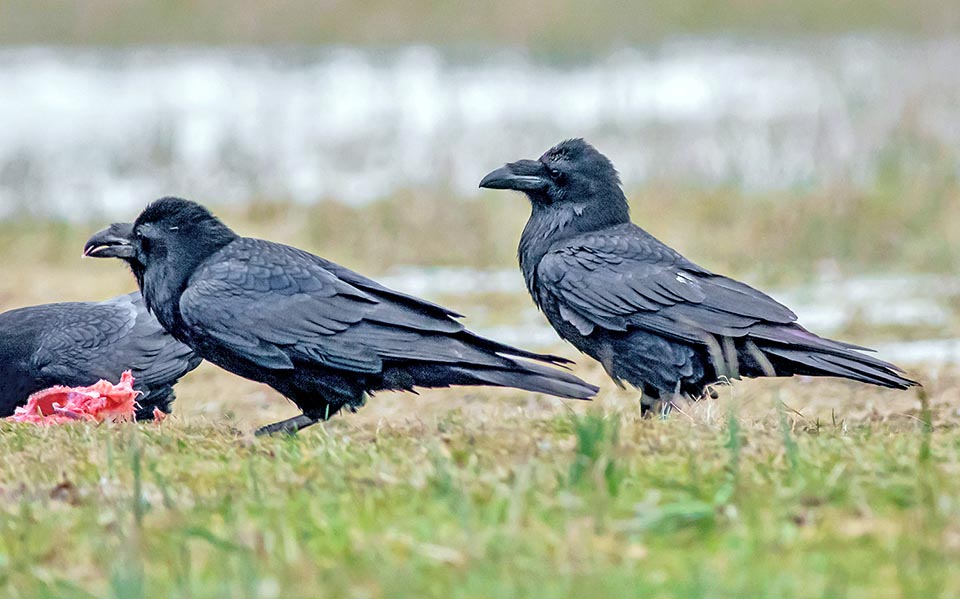
Here it’s on the ground with the first companions queuing for the feast. They are very social birds and soon others will join © Gianfranco Colombo
Churchill himself, during the Second World War, asked that the populations of the ravens present in the gardens of the Tower of London should be remarkably increased to avoid their disappearance!
The Common raven (Corvus corax Linnaeus, 1758) belongs to the order of the Passeriformes and to the family of the Corvidae and is, on an equal footing with the Thick-billed raven (Corvus crassirostris), the biggest species among the members of this family, and one of the biggest representatives of the order of the Passeriformes.
Majestic bird, master of the air, tamer of the winds, absolute protagonist in all the boreal hemisphere, but also a terrible predator when the occasion arises. Maybe it even deserves the epithet of imperial, given as a common name in Italy, due to the prowess and the courage it displays in its behaviours, and for the mettle with which it faces anyone of its competitors, a big raptor as well as a big animal. We often see it competing with bears and wolves while hoarding the food or contrasting in flight big eagles and vultures, facilitated by an innate aviation ability allowing them to perform evolutions, dips and twists and also “tonneaux”, impossible for any other bird.
In the meantime, this prowess it has, frequently reduces in a timid and hasty escape as soon as it sees a human being, whose presence certainly it can live without, as well as fear. In fact, this bird is suspicious and although being diffused in vast areas, it has never been frequently sighted.
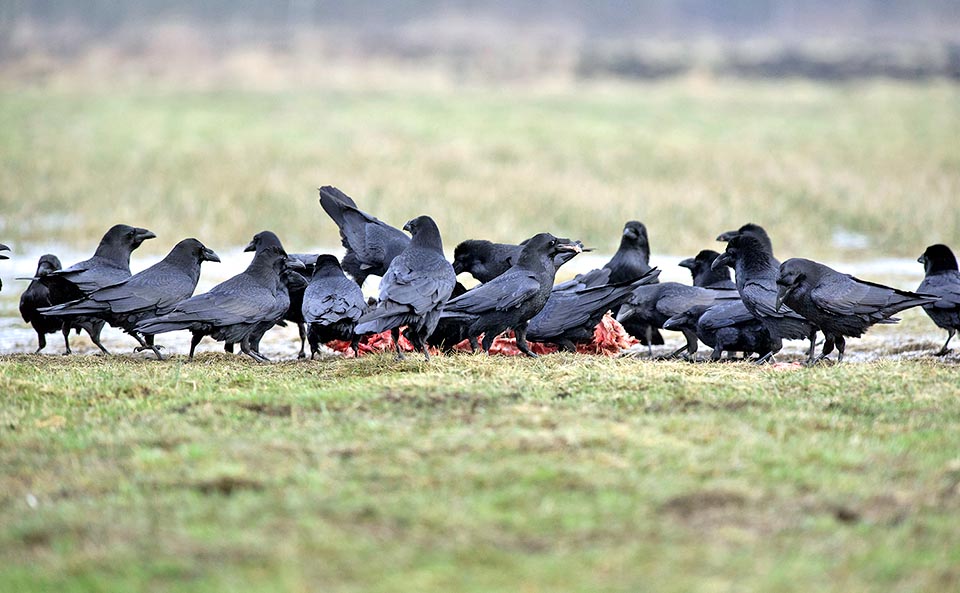
Here the entire flock is united to flesh out what remains after the passage of great carnivores as wolves and bears © Gianfranco Colombo
The etymology of the scientific binomen is quite simple, as both names have the same meaning: Corvus from the homonymous Latin term that rightly means raven and corax from the Greek “krozo” = to croak, therefore always with the sense of raven.
Common international names: in English, Common Raven; in German, Kolkrabe; in Spanish, Cuervo Grande; in French, Grand Corbeau; in Portuguese, Corvo and in Italian, Corvo imperiale.
Zoogeography
Among all corvids, the Common raven is the most diffused species, practically occupying all boreal hemisphere dry lands above the thirtieth parallel, reaching northwards the limits of the Arctic glacial seas.
North America, Alaska included, is totally occupied; as well as most of Greenland, reaching at a southern latitude almost all Mexico. Strangely enough, it is absent in the south-eastern part of the USA.
Europe is diffusely populated, excepting some uninhabited sections in the central part, but it is amply present in all the Mediterranean Basin and also on the north-western side of Africa. In Asia, it is absent only in India, in the Indochina peninsula and in the south-eastern part of China, where it is replaced by other species.
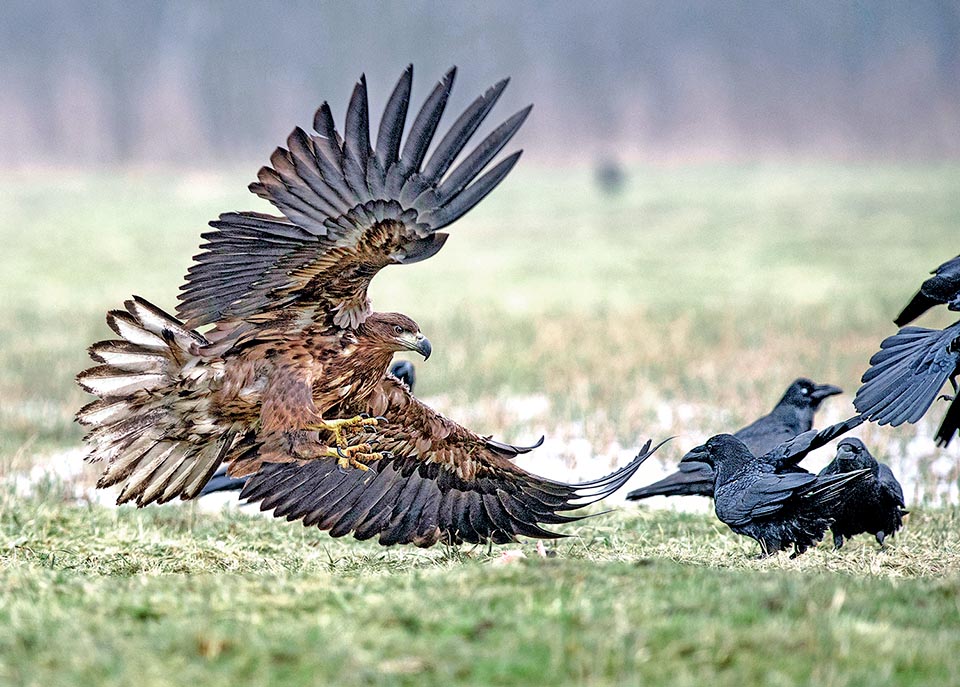
An eagle (Haliaeetus albicilla) enters the scene and the corvids dodge, but is not rare to see them, diners at respectful distance © Gianfranco Colombo
The Common raven usually is a sedentary species as it can hibernate also in quite hostile and difficult environments, rightly thanks to its possibility to take advantage of the hunting skills of large carnivores and also the predation, being a true raptor, towards weaker species.
Only the young individuals undertake short movements during their first years of youth, looking for new territories to conquer.
Ecology-Habitat
All mountain chains of the continental part of the northern hemisphere are inhabited by this species that has, rightly, as ideal environment high rocky mountains, impervious hills, covered by vast woods of broad-leaves as well as by coniferous ones, spaced by ample alpine valleys with open mountain pastures.
Also in the southern parts of their territories, the preferred area is always the mountainous one, even if, frequently, they go down, during their daily movements looking for food, also in plains, steppes and deserts as in the case of North Africa.
At higher latitudes, also the plain areas, the tundra, the marine coasts and the coastal islands, belong to their habitat and are extensively very occupied.
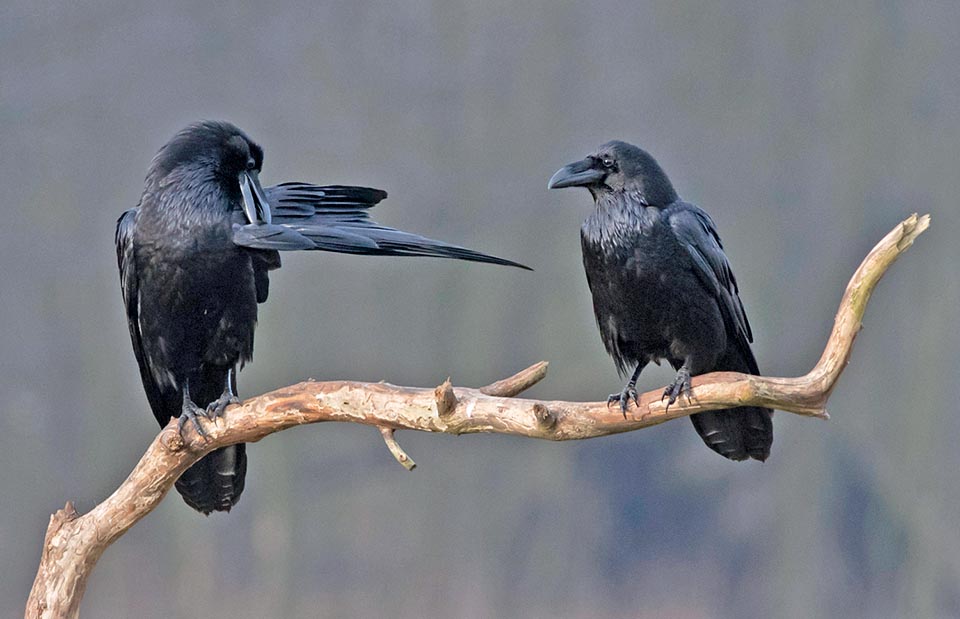
Dirty gravediggers? Birds of ill omen? Not at all. Here male smoothing the feathers for courting under the female ecstatic eyes © Gianfranco Colombo
The Common raven is a very adaptable bird and can live even in extreme situations like those met on the very high slopes of Himalaya, or Hindokush and of Karakorum beyond the vegetation limit among desolate stony grounds, where it can be seen well beyond the 5.000 m of altitude.
Morphophysiology
With a weight of 1,5/2 kg, a wingspan exceeding 120 cm and a total length of 65/70 cm, the Common raven is certainly unmistakable if compared with its consimilars. The most similar congeners have quite inferior dimensions and often they do not share, unless occasionally, the same territories.
The Common raven, though completely black, has a naked and prominent bill with neatly inferior dimensions and does not display the wedge-shaped tail of the common raven; the Carrion crow, the most similar species in the look, has a squared tail and more rounded wings and the Choughs, the alpine as well as the red-billed, even if frequenting the same mountain habitats, have absolutely inferior shape and size and a rather different flight.
The Common raven has a totally black plumage, with bluish metallic reflections, very robust and strong bill, not totally visible as covered at the base, on the upper jaw, by a bristly and hirsute hair covering half of its length.
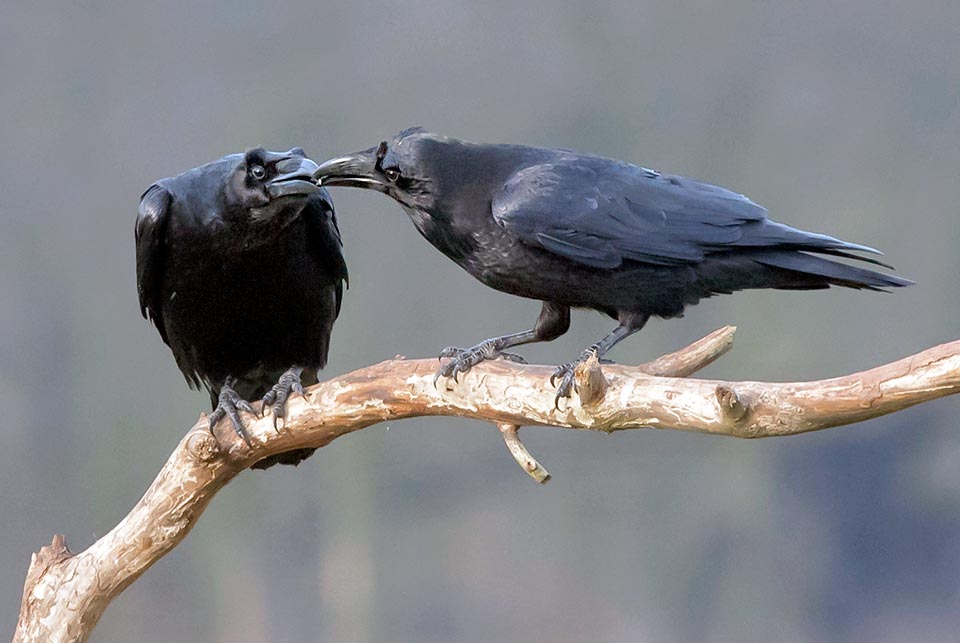
Then overly excited raises its eyebrows and offers it a small present, found who knows where. In their world is almost a wedding ring, maybe the seal of along love story that may last even 20 years, because the common raven is a very serious bird, monogamous for the whole life and particularly long lived © Gianfranco Colombo
Under the throat this down forms a short erectile beard, that, swelling, accentuates even more the size of its neck. The tail is very long with funnel-shaped rectrices that show an evident rhomboid shape when stretched in flight, a peculiar characteristic for recognizing this bird from any other boreal corvid when seen from far. The very robust paws are covered by hard scales that render them resistant to scratches and even to violent impacts and are equipped with long nails, very hard and sharp.
When with an open bill, it shows a marked red throat standing out remarkably on its very black livery of its plumage and the very dark brown eyes.
There is no dimorphism between the sexes, apart a minor but imperceptible difference in the female dimensions. The young are practically like the adults.
Seen the very extended range occupied by this corvid, has been determined a conspicuous number of subspecies of which
some interest Europe directly like the Corvus corax corax that occupies a great part of Europe up to Siberia, Corvus corax hispanus of the Iberian Peninsula and Italy, Corvus corax varius of the extreme part of Europe, Corvus corax laurencei of Greece, Middle East and western Asia, Corvus corax canariensis of the Canary Islands.
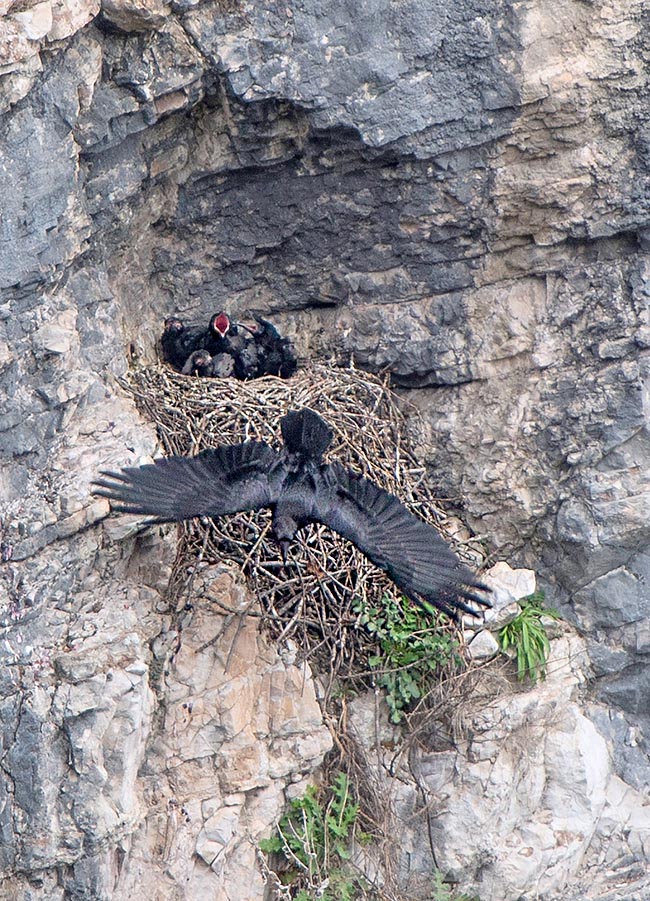
The site chosen for nesting is placed in impervious locations like this overhanging a rocky wall, to render impossible any approach by land. The female broods 4-7 eggs, rather small if compared to the size of the bird, for about 20 days © Gianfranco Colombo
For America, we have the Corvus corax principalis, the sinuatus and the clarionensis; for Asia, the tibetanus and the kamtschaticus, and finally, for Africa, the tingitanus.
Ethology-Reproductive Biology
The couple is monogamous for the whole life and only after the disappearance of one of the two members we may attend its replacement, even if we think that the survivor would not form a new couple.
The sexual maturity is reached by the third or fourth year of life and until that age the young live in small groups wandering around in areas even far from the native ones, though are tolerated invasions of territories already occupied by a couple.
The place chosen for nesting is found in inaccessible sites as well as in unreachable and unattainable positions, such as to render impossible any approach via land.
The step-to walls, precipitous and rocky slopes and tops of very high trees are the choice places where to build up the nest, places carefully chosen with attention, so much to be used for several years once verified their safety and reliability.
The Common raven is very precocious in nesting and already since the month of February, whatever weather condition may be present, the couple begins the courting and the construction of their nest.
A whole of coarse branches as base, on which are intertwined branchlets increasingly smaller, with moss, vegetal material, soft dried-up grasses, up to form an ample cup covered inside by animal wool and hairs.
A structure that can become after years of additions and rehashes, quite voluminous, thus, to collapse on itself ruinously during the bad weather or the bad season.
4 to 7 eggs are laid, rather small if compared to the size of the bird, of greenish light blue colour, diffusely spotted of dark brown and grey, that are brooded for about twenty days, during which the female never leaves the nest and is nourished by the male who provides for its sustenance.
The little ones are born naked and blind and are never left alone during the first days of their life till when they are covered by soft down and are sufficiently robust to face possible bad weather.
They will remain in the nest for four more weeks, until when they will be able to literally jump down from the nest, and start their first flight, assisted without fail by both parents.
Although already circumspect during all the moments of its life, the Common raven becomes unbelievably wary and suspicious when there is a brood waiting for it, so much incredible strategies of approach that is fluttering and hooping furtively from support to support before reaching the nest, even if well distant from the destination, to confuse any observing predator.
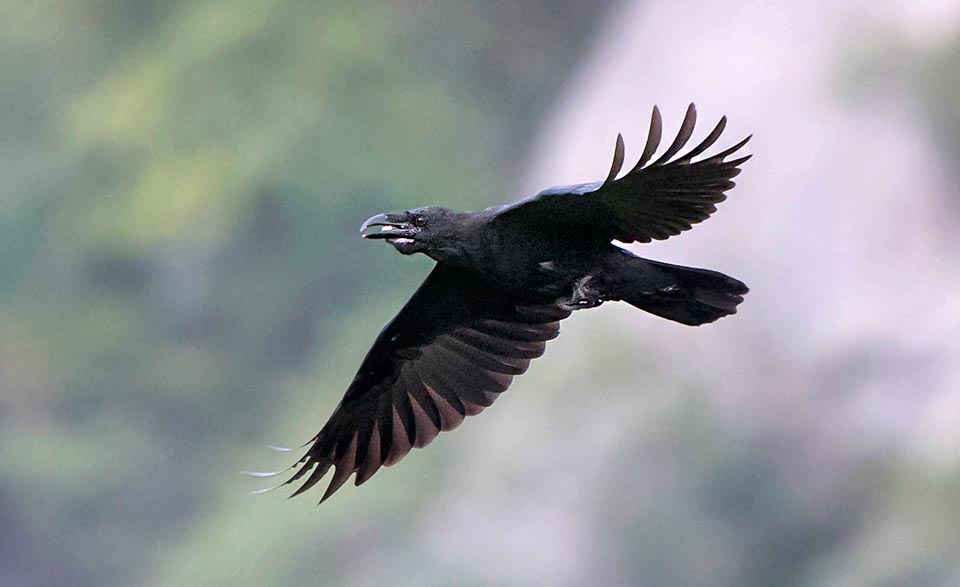
The male, when taking food to the nest, moves cautiously and circumspect not to reveal the place. If a predator approaches both parents attack it with courage © Colombo
In the case then that a danger would really appear, or a careless or a casual passage of the predator in the offing, both parents boldly throw themselves on the intruder, careless of the size and the strength of the opponent.
The Common raven has a remarkable life expectancy, as it can easily reach 20 years of age, but with the exceptions that can double the same when in captivity.
As aforementioned, characteristic of this bird is the strength and the ease in the art of flying, capacity in which it is excellent, often defying in its evolutions, the physical laws of gravity, so much to allow it aerial acrobatics of any kind and complexity.
Strong of this skill, this bird is, together with other high mountain crevids, and also a tireless joker. It is often seen transporting in the sky small pieces of wood or other objects and have fun, after having left them in free fall, to reach them with dives with closed wings and breathtaking swoops. Training that will allow to improve day by day this innate capacity up to the achievement of unsurpassed levels.
Not last is its innate intelligence that puts it at the apex in the world of birds, and that has granted it all guarantees for an everlasting success for the survival of the species.
→ To appreciate the biodiversity within PASSERIFORMES please click here.
